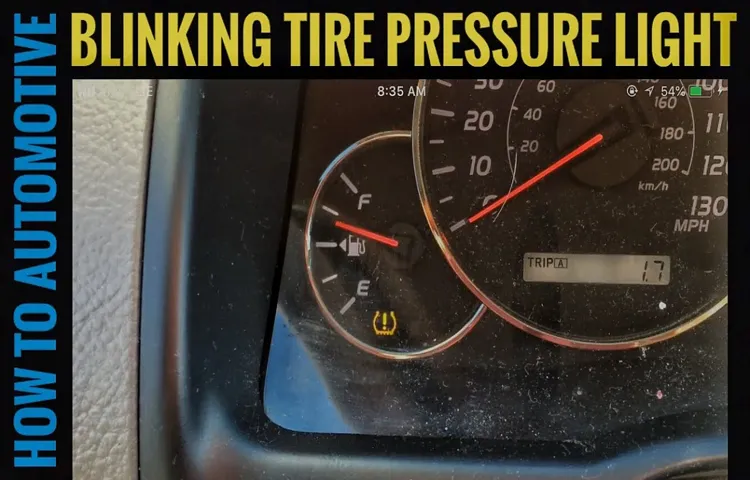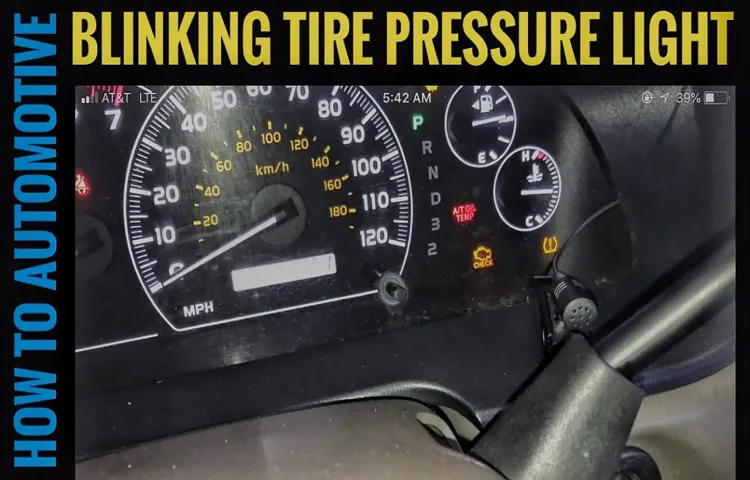Have you ever been driving down the road when suddenly your tire pressure light starts flashing? It can be a nerve-wracking experience, especially if you’re not sure what it means. Does it mean your tire is about to blow out? Or is it just a faulty sensor? In this blog post, we’ll break down exactly what a flashing tire pressure light means and what you should do about it. So fasten your seatbelts, and let’s dive in!
Table of Contents
Understanding Your Vehicle’s Tire Pressure Monitoring System (TPMS)
If your vehicle’s tire pressure light is flashing, it typically means that there is a problem with the Tire Pressure Monitoring System (TPMS). The TPMS is a safety feature that alerts you when the tire pressure is too low and can affect the handling of your vehicle. When the light flashes, it usually means that the system has detected a fault, such as a malfunctioning sensor or a low battery in one of the sensors.
It’s important to address the issue as soon as possible, as driving on underinflated tires can cause damage to the tires or put you at risk of a blowout. In some cases, simply adding air to the tires can solve the problem, but if the light continues to flash, it’s best to bring your vehicle to a technician to diagnose and repair the issue. Remember to regularly check the tire pressure and keep your tires properly inflated to avoid any potential problems.
What is TPMS?
TPMS, tire pressure monitoring system TPMS, or tire pressure monitoring system, is a technology that is designed to monitor the air pressure within the tires of your vehicle. This system can help to alert you when your tires are running low on air or when they are over-inflated, which can help to improve your safety and your vehicle’s overall performance. The TPMS sensor is located in each tire and sends a signal to your vehicle’s computer when the air pressure falls below a certain level.
This can help to prevent accidents and save you money on tire replacement and fuel costs. If the TPMS light comes on in your vehicle, it is important to check your tire pressure as soon as possible to prevent damage to your tires and ensure that your vehicle is operating at its best. Overall, having a TPMS system in your vehicle can be a valuable safety feature that can help you to stay safe on the road.

How Does TPMS Work?
TPMS If you’ve ever noticed a tire light come on your dashboard, you may be wondering what it means and how it got there. That small light is actually part of your vehicle’s tire pressure monitoring system (TPMS), which monitors the air pressure in each of your tires. TPMS uses sensors to measure the pressure in each tire and sends that information to your car’s computer.
If one or more tires’ pressure is lower than the recommended amount, the TPMS will trigger the warning light on your dashboard. This allows you to take action to fix the issue and avoid any potential safety hazards. TPMS is an essential part of your vehicle, as it helps you maintain proper tire pressure, which can improve fuel efficiency, prevent tire wear and tear, and ensure a safer driving experience.
Always make sure to check your tire pressure regularly, as TPMS is not a substitute for proper maintenance and care.
What Causes The TPMS Light To Flash?
If you’re driving and suddenly notice that your tire pressure monitoring system (TPMS) light is flashing, there could be a few possible causes. Sometimes, it’s simply due to a malfunction with the TPMS sensor or system, which may require repairs or replacement. However, more often than not, a flashing TPMS light indicates low tire pressure.
This could be caused by a number of things, such as a puncture, leak, or temperature changes. It’s important to address low tire pressure immediately, as it can lead to decreased fuel efficiency, increased risk of blowouts, and other safety hazards. Checking your tire pressure regularly can help prevent the TPMS light from flashing and keep your vehicle running smoothly.
Low Tire Pressure
Low tire pressure is one of the most common reasons why the TPMS light flashes on your vehicle dashboard. This can happen when the pressure in your tires drops below the recommended level due to a puncture, slow leak, or temperature changes. When this happens, it’s important to address the issue right away to prevent further damage to your tires.
Low tire pressure may also be an indication of wear and tear on your tires, which can lead to decreased fuel efficiency, reduced handling, and a shorter lifespan for your tires. To avoid this, it’s crucial to regularly check your tire pressure and make adjustments as necessary. By driving with properly inflated tires, you can ensure a safer, smoother ride and extend the longevity of your tires.
TPMS Sensor Malfunction
The TPMS light on your dash can be a frustrating sight, especially if you don’t know what’s causing it to flash. But don’t worry, it’s a common issue that can be easily fixed. One of the main causes of the TPMS sensor malfunction is low tire pressure.
When the pressure in your tires drops too low, the sensor will trigger the light to flash to let you know there is an issue. Other issues, such as a dead battery in the sensor or a faulty sensor, can also cause the light to flash. If you’re experiencing a TPMS sensor malfunction, it’s important to get your tires checked and have the sensor replaced or reprogrammed as needed.
Don’t ignore the flashing light, as it can affect your vehicle’s handling and performance, and even put you at risk on the road. Stay safe and keep your TPMS functioning properly by taking care of any issues as soon as they arise.
Dead or Faulty Battery in TPMS Sensor
TPMS light, Dead Battery, Faulty Sensor If the TPMS light is flashing on your dashboard, it could be due to a dead or faulty battery in the TPMS sensor. The TPMS sensor is responsible for monitoring the air pressure in your tires, and when its battery dies, it can no longer transmit data to the vehicle’s computer. This can cause the TPMS light to come on and stay on until the sensor is fixed or replaced.
Additionally, a faulty sensor can also cause the TPMS light to flash. If the sensor is not properly detecting the pressure in the tires, it will send an error signal to the car’s computer, which can trigger the flashing light. It’s important to address a flashing TPMS light as soon as possible, as it can indicate a potential safety issue with your vehicle’s tires.
If you suspect that your TPMS sensor battery is dead or the sensor is faulty, it’s best to take your car to a professional mechanic for an assessment and repair.
What to Do When The TPMS Light is Flashing
If you see your TPMS (Tire Pressure Monitoring System) light flashing, don’t panic! This usually means that one or more of your tires has low pressure, and it’s important to address the issue quickly to prevent any further damage. First, don’t ignore the light – check your tire pressure as soon as possible. You can do this using a tire pressure gauge, which you can purchase at most auto stores and even some gas stations.
Check each tire individually, and make sure they’re all inflated to the recommended PSI listed in your vehicle’s owner’s manual. If you don’t feel comfortable checking your tire pressure yourself, you can always take your vehicle to a mechanic or tire shop to have it checked. Remember, driving on low tire pressure can cause poor handling, decreased fuel efficiency, and even a blowout, so it’s important to address the issue promptly.
Check Your Tire Pressure
If you’re driving and suddenly notice the TPMS (Tire Pressure Monitoring System) light flashing, don’t panic. It simply means that your tire pressure needs attention. And while it may seem like a small issue, ignoring it can lead to bigger problems down the road.
To rectify the situation, first check your tire pressure with a gauge. The recommended pressure levels are usually printed on a label located on the driver’s side door jamb, glove compartment, or fuel door. If you find that your tires are underinflated, inflate them to the recommended pressure using an air compressor, available at most gas stations.
On the other hand, if your tires are overinflated, release some air until they reach the recommended levels. It’s important to note that a flashing TPMS light could also signal a faulty sensor, so if you’ve checked your tire pressure and it’s within the recommended range, schedule a maintenance appointment with your mechanic. Proper tire pressure not only ensures your safety on the road, but also improves fuel efficiency and extends the life of your tires.
So before setting off on a drive, take a few seconds to check your tire pressure and keep your TPMS light off.
Replace TPMS Sensor Battery or Malfunctioning Sensor
If you’ve noticed that your TPMS light is flashing, it could mean that there’s a problem with one or more of your tires. The most common issue is a low tire pressure, which can cause the light to come on. However, if you’ve verified that the pressure is correct and the light is still flashing, it’s likely that one of the sensors in your tire is malfunctioning.
Most TPMS sensors have batteries that need to be replaced periodically, so it’s worth checking to see if that’s the problem. If the battery isn’t the issue, you may need to replace the sensor altogether. This can be done by a professional mechanic, or if you feel comfortable, you may be able to do it yourself with some guidance.
Ignoring the flashing TPMS light can lead to serious consequences, so it’s important to address the problem as soon as possible.
Preventing TPMS Issues and Accidents
The sight of a flashing tire pressure light can be alarming, but it’s usually a sign that something’s not quite right with your TPMS (Tire Pressure Monitoring System). When the light flashes on and off, it’s indicating that there is a problem with the system and that it needs attention. It could mean that the system needs to be recalibrated or that one or more of your tires has lost pressure.
Ignoring the light can be dangerous, as it could lead to accidents or other types of tire-related issues. The best way to prevent TPMS issues and potential accidents is to keep an eye on your tire pressure, check it regularly, and have your tire pressure monitoring system checked as soon as the light starts flashing. By being proactive and taking care of your tires and TPMS, you can ensure that your vehicle is safe to operate and that you and your passengers arrive at your destination without incident.
Regularly Check Your Tire Pressure
Regularly checking your tire pressure is a crucial step in preventing TPMS issues and accidents. Underinflated or overinflated tires can significantly impact your vehicle’s stability, braking, and fuel efficiency. It’s essential to maintain the correct tire pressure, and the only way to do that is by checking it regularly.
Ideally, you should check your tire pressure once a month or before going on a long road trip. Not only does it help prevent accidents, but it also helps extend the life of your tires. Think of it like a balloon.
If you inflate it too much, it can pop, but if you don’t inflate it enough, it won’t be useful. By maintaining the correct tire pressure, you are ensuring that your vehicle is operating at its best capacity, resulting in a smooth and safe ride. So the next time you’re at the gas station, take a few minutes to check your tire pressure.
It may save you from a costly and dangerous accident in the future.
Replace TPMS Sensors When Needed
TPMS sensors As car owners, we often forget about the small but crucial parts of our vehicles that help us drive safely. One such component is the TPMS sensors, which stands for tire pressure monitoring system. These sensors continuously monitor the air pressure in our tires, alerting us if there’s a problem.
However, many drivers neglect to replace their TPMS sensors even when they begin to malfunction, which can lead to serious accidents. That’s why it’s essential to keep an eye on your TPMS sensors and have them replaced when needed. Not only will this ensure your safety on the road, but it can also prevent costly repairs in the long run.
By taking care of your TPMS sensors, you’re investing in the longevity and functionality of your car. So, the next time you notice something seems off with your tire pressure monitoring system, don’t wait until it’s too late. Get your TPMS sensors replaced promptly, and stay safe on the road.
Consult a Professional Mechanic for Assistance
When it comes to maintaining your tires, it’s imperative to pay attention to your TPMS (Tire Pressure Monitoring System) to prevent any issues or potential accidents on the road. One of the simplest ways to keep your TPMS in top shape is to consult with a professional mechanic. They can help ensure your TPMS is functioning correctly and provide regular maintenance that will extend its lifespan and catch any issues before they spiral out of control.
A mechanic can also recommend the best tires for your vehicle based on your driving habits and needs. Remember, regular maintenance will keep your tires and TPMS functioning correctly and provide peace of mind on the road.
Conclusion
In conclusion, the flashing tire pressure light on your car’s dashboard is like a call from your tires telling you “Hey, we need some attention here!” It’s not just a random signal to annoy you, but a warning that your tires are either under-inflated or over-inflated. Ignoring this signal can lead to unsafe driving conditions, poor fuel efficiency, and wear and tear on your tires. So, be sure to give your tires the TLC they deserve and keep that tire pressure light from flashing!”
FAQs
What are the reasons for a flashing tire pressure light?
A flashing tire pressure light may indicate low tire pressure, a fault in the tire pressure monitoring system, a damaged tire, or a problem with the sensor.
How do I know if my tire pressure is too low?
You can check the tire pressure using a tire pressure gauge or by visiting a gas station with a tire pressure monitor. If the pressure is lower than the recommended level, add more air to the tire.
Can I still drive with a flashing tire pressure light?
It is not recommended to drive with a flashing tire pressure light, as it may indicate a serious issue with your tires. If you must drive, reduce your speed and visit a mechanic as soon as possible.
What happens if I ignore the flashing tire pressure light?
Ignoring the flashing tire pressure light can lead to increased risk of accidents, decreased fuel efficiency, and damage to your tires or wheels. It is important to address the issue promptly.
How often should I check my tire pressure?
It is recommended to check your tire pressure at least once a month, or before long trips. This can help prevent the likelihood of a flashing tire pressure light and ensure optimal tire performance.
What should I do if my tire pressure light stays on after I add more air?
If the tire pressure light stays on after adding air, it may be an indication of a more serious issue. Visit a mechanic to have your tire pressure monitoring system checked.
Can I reset the tire pressure monitoring system myself?
In some cases, you may be able to reset the tire pressure monitoring system yourself. Refer to your vehicle’s manual for instructions, or visit a mechanic for assistance.



